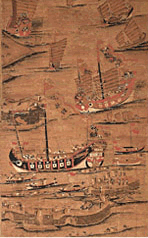
| Japanese viewpoint |
|
Ryukyu viewpoint |
| Location of Ryukyu Islands |
| Asian trade |
| Japanese invasion |
| Taiwan Expedition of 1874 |
| Ch'ing viewpoint |
| Aboriginal viewpoint |
The Ryukyu Kingdom (Ryukyuan: 琉球國 (ruchu-kuku), Japanese: 琉球王國ryukyu-o-koku),
Traditional Chinese: 琉球國 (liuqiuguo)) was an independent kingdom which ruled
most of the Ryukyu Islands from the 15th century to the 19th century. The
Kings of Ryukyu unified Okinawa Island and extended the kingdom to the Amami
Islands in modern-day Kagoshima Prefecture, and the Yaeyama Islands near
Taiwan.

In the three Ryukyu historical annals—Chuzan Seikan (中山世鑑, Mirror of Chuzan),
Chuzan Seifu (中山世譜, Genealogy of Chuzan), and Kyuyo (球陽, Chronicle of
Ryukyu)—the history of the Ryukyu Kingdom began with the Tenson Dynasty
(天孫王朝, Dynasty of Heavenly Descent), which was said to have lasted 17,000
years. Many historians today believe that this is a mythological legend
created in the 16th or 17th century to lend more legitimacy to the ruling
dynasty, the Sho family, over other local aristocratic families.
The Tenson Dynasty ended with three kings of the Shunten Line (舜天王朝),
lasting from 1187 to 1259. According to Chuzan Seikan, written by Sho Shoken,
the founder of the dynasty was a son of Minamoto no Tametomo, a Japanese
aristocrat and relative of the Imperial family. Minamoto no Tametomo was
exiled to the Izu Islands after he failed to gain power in the Kyoto court;
he then fled and drifted to Ryukyu, where his son Shunten established their
own dynasty. Some Japanese and Chinese scholars claim that the Shunten
dynasty was again invented by the Sho family historians, for the same reason
that they created the Tenson legend.
In the 14th century, small domains scattered on Okinawa Island were unified
into three principalities: Hokuzan (北山, Northern Mountain), Chuzan (中山,
Central Mountain) and Nanzan (南山, Southern Mountain). This was known as the
Three Kingdoms or Sanzan (三山, Three Mountains) period. These three
principalities, or tribal federations led by major chieftains, battled, and
Chuzan emerged victorious, receiving Chinese investiture in the early 15th
century. That is to say, the leaders of Chuzan were officially recognized by
China as the rightful kings over those of Nanzan and Hokuzan, thus lending
great legitimacy to their claims, if not victory outright. The ruler of
Chuzan passed his throne to king Hashi; he received the surname "Sho" from
the Ming emperor in 1421, becoming known as Sho Hashi, 尚巴志). Hashi had
already conquered Hokuzan in 1416 and Nanzan in 1429, uniting the island of
Okinawa for the first time, and founding the first Sho Dynasty.
Sho Hashi adopted the Chinese hierarchical court system, built Shuri Castle
and the town as his capital, and constructed Naha harbor. Several
generations later, in 1469, King Sho Toku died without a male heir; a
palatine servant declared he was Toku's adopted son and gained Chinese
investiture. This pretender, Sho En, began the Second Sho Dynasty. Ryukyu's
golden age occurred during the reign of Sho Shin, the second king of that
dynasty, who reigned from 1478-1526.
Major events
•1372 The first Ming dynasty envoy visits Okinawa, which had been divided
into three kingdoms, during the Sanzan period. Formal tributary relations
with the Chinese Empire begin.
•1419 Chuzan, led by Sho Hashi, occupies Nakijin gusuku, capital of Hokuzan.
•1429 Chuzan occupies Shimajiri Osato gusuku, capital of Nanzan, unifying
Okinawa Island. Sho Hashi establishes the Kingdom of Ryukyu, ruling as king
with his capital at Shuri (now part of modern-day Naha).
•1470 Sho En (Kanemaru) establishes the Second Sho Dynasty.
•1477 The third king, Sho Shin, ascends to the throne. Golden age of the
kingdom.
•1609 (April 5) daimyo (Lord) of Satsuma in southern Kyushu conquers the
kingdom. King of Ryukyu becomes a Japanese vassal.
•1624 Lord of Satsuma annexes the Amami Islands.
•1846 Dr. Bernard Jean Bettleheim (d. 1870), a British Protestant
missionary, arrives in Ryukyu Kingdom. He establishes the first foreign
hospital on the island at the Nami-no-ue Temple.
•1853 Commodore Matthew Perry of the US Navy visits the kingdom. Bettleheim
leaves with Perry.
•1866 The last official mission from the Qing Empire visits the kingdom.
•1874 The last tributary envoy to China is dispatched from Naha.
•1879 Japan replaces the Ryukyu han with Okinawa Prefecture, formally
annexing the islands. King Sho Tai (尚泰) is given the title of marquis (藩王
Han'o) and removed to Tokyo.
Reference
http://en.wikipedia.org/wiki/Ry%C5%ABky%C5%AB_Kingdom